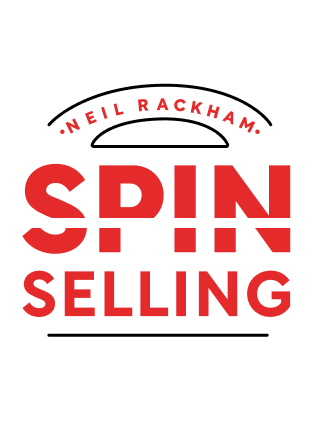

This article is an excerpt from the Shortform summary of "Spin Selling" by Neil Rackham. Shortform has the world's best summaries of books you should be reading.
Like this article? Sign up for a free trial here .
Do you want to know how to do a sales call? Are you looking for tips and advice on how to have a successful call?
Learning how to do a sales call can be a challenge. But the SPIN selling method offers a clear strategy in the four stages of a sales call, along with the way you can ask questions to reach solutions.
Four Stages of a Sales Call
Despite the different customer psychology and sales skills required, all sales calls have basic similarities regardless of the dollar value. Here are the four typical stages of a sales call and how they apply to major sales:
1) Warming up/Opening: The opening is how you introduce yourself, establish connection, and start the conversation. Sales training often teaches that the customer’s impression in the first few minutes of the call is critical to the sale. The opening may have a bearing in a brief one-call interaction, but in large, protracted sales, your opening is less important than what you do in the next stage: the investigating stage.
2) Investigating: In this stage, you ask questions to get information. You’re trying to discover needs or to better understand the customer. Ability to ask investigating or probing questions is arguably the most important sales skill, particularly in major sales. Improving investigating skills can increase large-account sales by as much as 20%.
3) Demonstrating capability/value: Once you understand the customer’s needs, the next step is to show how your product or service can help. In larger sales, where you’re often selling a broader solution, you need to show how your solution solves the customer’s specific problems in a way that makes it worth the cost.
4) Getting commitment: To be a success, a sales call must end with a customer commitment.
In small sales, the customer usually commits to buying the product, while in large sales, she may agree to another meeting, or to provide access to a decision-maker. Such intermediate steps are called advances because they advance the sale by moving the customer toward a decision. The way you choose how to do a sales call depends on the type of sale and length of the sales cycle.
Tips for the Investigating Stage
Stages of a sales call have all the stages, but the emphasis may vary—for instance, the warm-up stage may be extended or very brief, depending on the customer’s preferred business style.
Traditional sales training and many sales managers emphasize the commitment stage—closing the sale—as most important. But in a major sale, investigating is the most important stage. It can account for the majority of the time spent on a call. In large sales, reps ask more questions than are asked in small sales.
Questions Drive Success
Questions are crucial to success in many types of interactions besides sales—for instance, negotiations, management interactions, performance interviews, and group discussions. The more questions you ask, the more likely you are to meet your objectives, and the more likely you are to learn how to do a sales call effectively.
There are different types of questions, some of which are more effective than others. Sales training has emphasized two types—open and closed questions—dating back to at least the 1920s.
Closed questions are directive and usually elicit a “yes” or “no” answer—for example, “Have you purchased new equipment in the last five years?” Closed questions are less engaging, which can make them useful in dealing with long-winded customers, or when you have little time.
Open questions are non-directive and encourage an in-depth answer—for example, “Can you tell me more about your business?” or “What’s your biggest concern?” They’re effective at eliciting information because they get the customer talking. Sometimes, you learn something you didn’t expect.
However, the research on which this book is based found no correlation between using either open or closed questions and sales success. Researchers found no benefit for one type over the other in major sales calls, although sales training has long emphasized the importance of asking mostly open questions instead of closed questions, no matter where you are in the stages of a sales call.
A Better Approach
Researchers found that successful reps handled the investigating stage differently. Rather than focusing on asking open and closed questions in large sales, they asked four different types of questions in a sequence. These successful reps’ investigating questions can be described as the SPIN sequence as the best way on how to do a sales call.
1) S-Situation questions: Start by asking fact-finding and background questions, such as
“What do you see as the company’s biggest growth opportunities?” Asking too many of these questions can impose on the customer’s time and patience, so use them judiciously.
2) P-Problem questions: Once you understand the customer’s situation, ask questions that explore problems or issues your product or solution can solve—for instance, “Are you concerned about meeting your clients’ quality standards with your aging equipment?” Less experienced reps may not ask enough of these questions.
3) I-Implication questions: Asking good situation and problem questions may be enough to win a small sale. However, you need to go further in large sales and ask a more sophisticated question that explores the implications or ramifications of a customer’s problem—for example, “How will this affect your fourth-quarter results?”, or “What will this mean for your biggest customer?” The point is to underscore a problem’s significance, and create a sense of urgency for solving it. These are more difficult questions to frame, even for experienced salespeople.
4) N-Need-payoff questions: These questions lead the customer to articulate the benefits of your product or solution. For example, you might ask, “How useful would it be if we could increase your output by 10%?”, or “How would being able to reduce errors help you?” Need-payoff questions contribute strongly to sales success. Top reps ask these questions 10 times more often than average reps.
Asking SPIN questions is the best way to use the investigating phase of a sales call.
Chapter 4 examines in detail how you can use them to improve your success in major sales.
With practice, you can learn how to do a sales call effectively. The SPIN selling method focuses on getting to the root of customer needs, and the four stages of a sales call are part of why the method works.

———End of Preview———
Like what you just read? Read the rest of the world's best summary of Neil Rackham's "Spin Selling" at Shortform .
Here's what you'll find in our full Spin Selling summary :
- What the SPIN in SPIN Selling stands for
- How to demonstrate real value to the person you're selling to
- How to get commitment from your customer to close the sale fast






